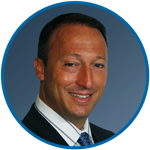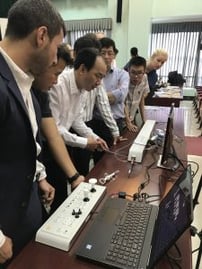Why I’ll Never Go Back to a Traditional Radiology Practice
One in a series from people sharing their experiences as vRad teleradiologists. In this entry, Jonathon Lee, MD, recounts how, through his search for...

Remote radiologist jobs with flexible schedules, equitable pay, and the most advanced reading platform. Discover teleradiology at vRad.

Radiologist well-being matters. Explore how vRad takes action to prevent burnout with expert-led, confidential support through our partnership with VITAL WorkLife. Helping radiologists thrive.

Visit the vRad Blog for radiologist experiences at vRad, career resources, and more.

vRad provides radiology residents and fellows free radiology education resources for ABR boards, noon lectures, and CME.

Teleradiology services leader since 2001. See how vRad AI is helping deliver faster, higher-quality care for 50,000+ critical patients each year.

Subspecialist care for the women in your community. 48-hour screenings. 1-hour diagnostics. Comprehensive compliance and inspection support.

vRad’s stroke protocol auto-assigns stroke cases to the top of all available radiologists’ worklists, with requirements to be read next.

vRad’s unique teleradiology workflow for trauma studies delivers consistently fast turnaround times—even during periods of high volume.

vRad’s Operations Center is the central hub that ensures imaging studies and communications are handled efficiently and swiftly.

vRad is delivering faster radiology turnaround times for 40,000+ critical patients annually, using four unique strategies, including AI.
.jpg?width=1024&height=576&name=vRad-High-Quality-Patient-Care-1024x576%20(1).jpg)
vRad is developing and using AI to improve radiology quality assurance and reduce medical malpractice risk.

Now you can power your practice with the same fully integrated technology and support ecosystem we use. The vRad Platform.

Since developing and launching our first model in 2015, vRad has been at the forefront of AI in radiology.

Since 2010, vRad Radiology Education has provided high-quality radiology CME. Open to all radiologists, these 15-minute online modules are a convenient way to stay up to date on practical radiology topics.

Join vRad’s annual spring CME conference featuring top speakers and practical radiology topics.

vRad provides radiology residents and fellows free radiology education resources for ABR boards, noon lectures, and CME.

Academically oriented radiologists love practicing at vRad too. Check out the research published by vRad radiologists and team members.

Learn how vRad revolutionized radiology and has been at the forefront of innovation since 2001.

%20(2).jpg?width=1008&height=755&name=Copy%20of%20Mega%20Nav%20Images%202025%20(1008%20x%20755%20px)%20(2).jpg)

Visit the vRad blog for radiologist experiences at vRad, career resources, and more.


Explore our practice’s reading platform, breast imaging program, AI, and more. Plus, hear from vRad radiologists about what it’s like to practice at vRad.

Ready to be part of something meaningful? Explore team member careers at vRad.
3 min read
 Josh Sokol, MD
:
June 25, 2019
Josh Sokol, MD
:
June 25, 2019

Over 4 billion people – two-thirds of the global population – do not have access to imaging technology or radiology services, according to RAD-AID. The lack of effective diagnostic tools has dire consequences for patients in unserved and underserved regions of the world.
vRad teleradiologist Josh Sokol, MD wants to tackle this problem and improve access to diagnostic imaging. Just over a year after launching First Read Initiative, and raising $114,000 in donations, Dr. Sokol took time to answer some questions about the project.
The mission of First Read Initiative is to make diagnostic studies accessible to patients in unserved and underserved regions around the globe.
Over the years, many of us at vRad volunteered to read films for organizations like Doctors Without Borders and Haitian Relief. It was very satisfying.
As a teleradiologist, it seemed like a no-brainer to provide interpretations for underserved areas. “Just send the CAT scans and I’ll read them for free.” I was feeling pretty good about this until I learned that most patients have no access to imaging equipment, let alone a technician to operate it, electricity to power it, or an internet connection to deliver it to a radiologist halfway around the world.
To empower people in the areas of greatest need, we had to first provide them with financial resources, imaging technology and education. Only then could our interpretive skills be of any use.
First Read Initiative was formed to bring imaging resources to those who need it most. We may not always be able to travel to remote villages around the world to provide hands-on care, but we can contribute valuable funding and diagnostic expertise to the medical teams onsite from the chairs in our reading rooms.
At first, it did seem overwhelming. Then I connected with a number of great organizations already delivering diagnostic resources to disadvantaged areas all over the globe – organizations like RAD-AID, Project C.U.R.E., and UnitsUSA just to name a few.
So, instead of reinventing the wheel, we decided to “help the helpers” by setting up a system where any of vRad’s 500 radiologists can automatically donate their proceeds from their first X-ray of every shift (or more if they wish) to the organization. The radiologist simply signs up for the program, logs in for their shift and begins reading. All logistics are taken care of.
With over 500 radiologists connected by one of the most advanced communications and workflow systems in the medical industry, we are in the best position to respond to this need.

We raised over $114,000 in our inaugural year. Among the things this helped us provide were:
• An ultrasound machine to be used to train technologists all over the world
• Thirteen computers to support the PACS system at the main hospital in Georgetown, Guyana
• Sponsorships to attend our recent CME conference in Las Vegas for two of the first residency classes ever from Georgetown
• Radiation reduction education for a children’s hospital in Thailand
• Efforts to bring mobile ultrasound to rural Appalachia
Of course, there’s still a lot more to do. I mean, 60% of the world’s population does not have access to imaging of any kind. All of us at First Read want to be part of the solution.
We are off to a good start and are anxious to build momentum in the coming years.
It took no time to convince Ben [Strong, vRad chief medical officer] and Shannon [Werb, president and chief operating officer]. I think they were 100% on board before my presentation was done and both were instrumental in providing resources to bring it to life.
In addition to acknowledging MEDNAX and vRad management for their unwavering commitment to this program, I would like to thank those who join me on our board of directors: Shannon Werb, Ben Strong, MD, Mary Huff, MD, and Katie Lozano, MD as well as our financial systems manager Kelly Wunderlich and Luanne Kuna, our director of project management.
First Read was created as a way for vRad radiologists to connect with one another and unite behind efforts to make imaging accessible throughout the world.
For vRad radiologists, the best way to help is to sign up and read a few X-rays each day during your work shift. Simply visit the First Read page in RadHQ and choose to contribute the proceeds from one or more X-rays per shift or a monthly dollar amount. Although we call it the First Read Initiative, I like to feel that I am donating the last 5 X-ray reads of my shift. I leave work feeling great having given just a few minutes each day to help out people all over the world.
If you know of a radiology-centric charity we should consider supporting, or if you wish to donate time, money or equipment, please contact us through the First Read Initiative website.
In our first year, we worked exclusively with RAD-AID. This year, we have already had requests from 4 other charities. A lot of people need our help. First Read Initiative is here to provide an easy way for people to work locally and help globally.
.png)
One in a series from people sharing their experiences as vRad teleradiologists. In this entry, Jonathon Lee, MD, recounts how, through his search for...
.jpg)
After residency, I was full of energy and had a solid plan: I’d work in private practice and take on a part-time job in teleradiology. At the time,...
.jpg)
Imagine having a 150-bed hospital without a radiology department. Imagine being an obstetrician in an isolated area without access to ultrasound....
vRad (Virtual Radiologic) is a national radiology practice combining clinical excellence with cutting-edge technology development. Each year, we bring exceptional radiology care to millions of patients and empower healthcare providers with technology-driven solutions.
Non-Clinical Inquiries (Total Free):
800.737.0610
Outside U.S.:
011.1.952.595.1111
3600 Minnesota Drive, Suite 800
Edina, MN 55435